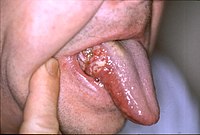
Photo from wikipedia
INTRODUCTION As early detection of oral cancers is associated with better survival, oral cancer screening should be included in dental visits for adults. This study examines the rate and predictors… Click to show full abstract
INTRODUCTION As early detection of oral cancers is associated with better survival, oral cancer screening should be included in dental visits for adults. This study examines the rate and predictors of oral cancer screening exams among U.S. adults with a recent dental visit. METHODS Individuals aged ≥30 years who received a dental visit in the last 2 years, in the 2011-2016 National Health and Nutrition Examination Survey were analyzed in December 2018. Weighted multivariable logistic regression models examined the likelihood of intraoral and extraoral oral cancer screening exams, adjusting for age, sex, race/ethnicity, education, marital status, poverty income ratio, health insurance, tobacco smoking, and alcohol consumption. Subgroup analyses were conducted among races/ethnicities, smokers, and alcohol consumers. Statistical significance was set at p<0.01. RESULTS A total of 37.6% and 31.3% reported receiving an intraoral and extraoral oral cancer screening exam, respectively. Minority racial/ethnic groups versus white, non-Hispanics, less-educated versus more-educated, uninsured and Medicaid-insured versus privately insured, and low-income versus high-income participants were less likely to have received intraoral or extraoral oral cancer screening exams. There was no difference in the likelihood of being screened based on smoking status. Alcohol consumers were more likely to be screened. Among subgroups, less-educated and low-income individuals were less likely to be screened. CONCLUSIONS A significantly higher proportion of minority race/ethnicity and low SES individuals report not receiving an oral cancer screening exam, despite a recent dental visit. This selective screening by dental professionals is incompliant with guidelines and concerning because these groups are more likely to present with an advanced stage of oral cancer at diagnosis. An understanding of the reasons for discriminatory oral cancer screening practices could help develop effective interventions.
Journal Title: American journal of preventive medicine
Year Published: 2019
Link to full text (if available)
Share on Social Media: Sign Up to like & get
recommendations!